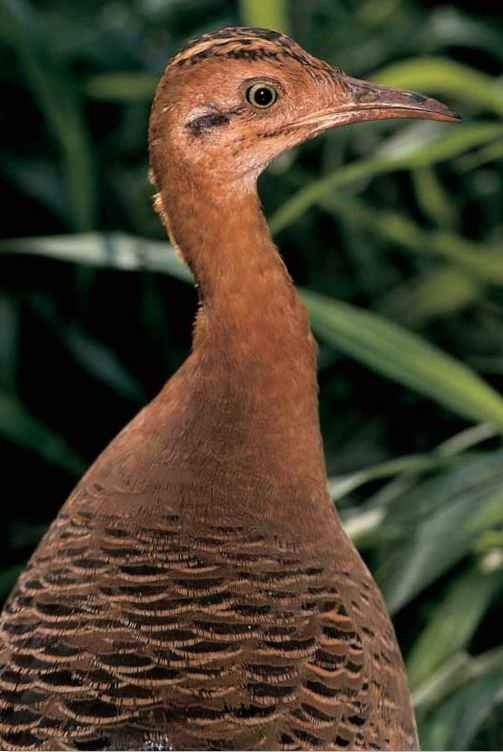ORDER
Tinamiformes
FAMILY
Tinamidae
GENUS
key features
• Ground-dwelling birds with a distinctive call; live in grasslands and forests in Central and South America
• Well camouflaged to hide from predators
• Male mates with several females before incubating all their eggs in one nest
• Glossy eggs are among the most brightly colored of all birds’ eggs
where in the world?
Found throughout South and Central I America, north as far as Mexico; absent from Tierra del Fuego and the Falkland Islands

LIFECYCLE
In many birds, the male leaves parental duties to the female. But in the tinamous, the male incubates the eggs while his mate wanders off to breed with other males.
HABITAT
As specialist ground dwellers, tinamous exploit almost every habitat in Central and South America. Each species has nesting and feeding habits that help reduce competition.
In the north of their range, the birds favor dense forest, while farther south they inhabit open grassland and savannah woodland. The Puna tinamou is found in the Andes at altitudes of up to 17,500′.
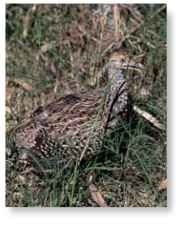
A Earthbound Tinamous spend almost all their lives on ground.
CONSERVATION
In the late 19th century, tinamous were hunted or exported as “South American partridges” before controls were introduced. In the early 20th century, tinamous were unsuccessfully introduced to Europe and the U.S. as gamebirds. There is little information on many species, but eight of them are classified as threatened. Certain species are restricted to one type of habitat. If this area is small, hunting or habitat destruction may eliminate the bird.
FOOD & FEEDING
An opportunistic feeder the tinamou eats a wide variety of vegetation and animal matter; Feeding almost entirely on the ground, it eats mainly fruits and seeds, including cereal crops. Leaves, buds and shoots are especially important for species living in cold, bleak areas of grassland where other food is hard to find. Insects and other invertebrates are part of the diet of many tinamous.
The tinamou finds its food by walking slowly through the long grasses or deep forest undergrowth, picking up morsels or rummaging in soil or leaf litter with side-to-side movements of its bill. Its nostrils are located at the base of the bill to prevent them from becoming clogged with soil as it digs.
The tinamou’s predators include foxes, weasels, falcons and introduced mongooses.
The ends of the tinamou’s feather filaments are solidly joined rather than being hooked together as is the case with most other birds. Thus the tinamou’s wings make a whistling sound when the bird is in flight.
One of the tinamou’s closest relatives is the rhea — a flightless bird that is up to 4.5′ tall.
BEHAVIOR
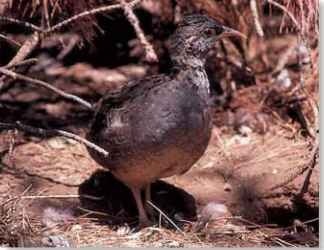
A Songs of the forest Calls are simple, high-pitched and melodious.
Forest species are solitary, skulking in dense undergrowth, but grassland tinamous, such as the spotted nothura, live in groups of 20-30 birds. In winter, up to 100 may gather traveling widely to find food. The more birds in the flock, the more likely they are to locate food — and spot predators. Should an enemy approach, the birds utter harsh alarm calls to warn each other.
If surprised by a predator, the tinamou bursts from cover, flying swiftly to another hiding place. But it cannot sustain its flight for long and, if caught in open areas, may dart into any available burrow until the danger has passed.The solitary tinamou is one of many forest species that roost in trees to avoid danger
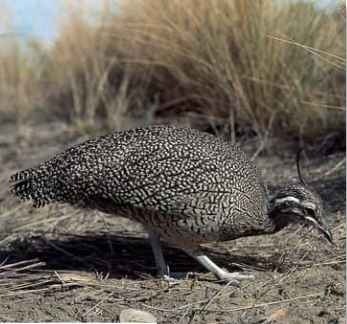
A Bigger bite
Tinamous may eat mice and even small snakes.
ON THE ALERT
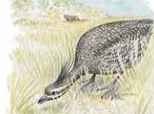
Tasty pickings…
While feeding, a crested tinamou remains alert, but relies on its dappled plumage to hide it.
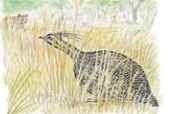
Enemy approaching…
A pampas cat approaches. The tinamou freezes, trying to look more like a shrub than a bird.
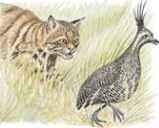
On the run…
The cat is not fooled — it makes its move.The tinamou runs, calling to warn other birds of the danger.
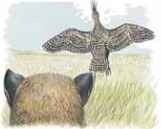
Flight to freedom
As the cat pounces, the tinamou bursts into the air, leaving the startled cat behind.
BREEDING
Both male and female tinamous mate several times with different partners to ensure large numbers of healthy chicks.
The male scrapes out a rudimentary nest on the ground and lines it with dry leaves, grass or turf.He then attracts females with calls and mates with any that approach. Each female abandons her eggs after laying them, and then searches for other mates.
The male remains motionless while incubating the eggs, relying on his dull plumage to provide camouflage. When he leaves the nest to feed, he covers the eggs with leaves and feathers.
Tinamou chicks feed themselves within hours of hatching, but their father helps by dropping
food nearby. They mature quickly and can make short, clumsy flights within a few days.
Nothing fancy Males court mates with a simple display.
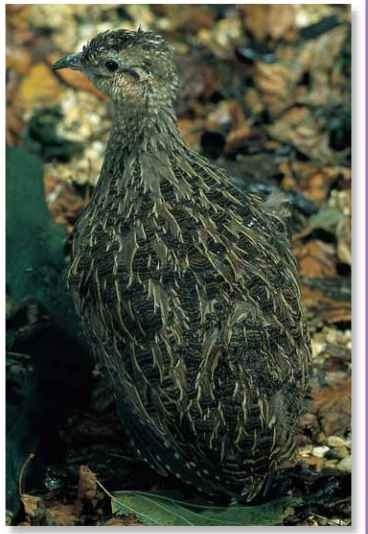
Profile
Elegant Crested Tinamou
With its compact build and dappled brown plumage, the elegant crested tinamou is equipped for living on the ground in open grasslands.
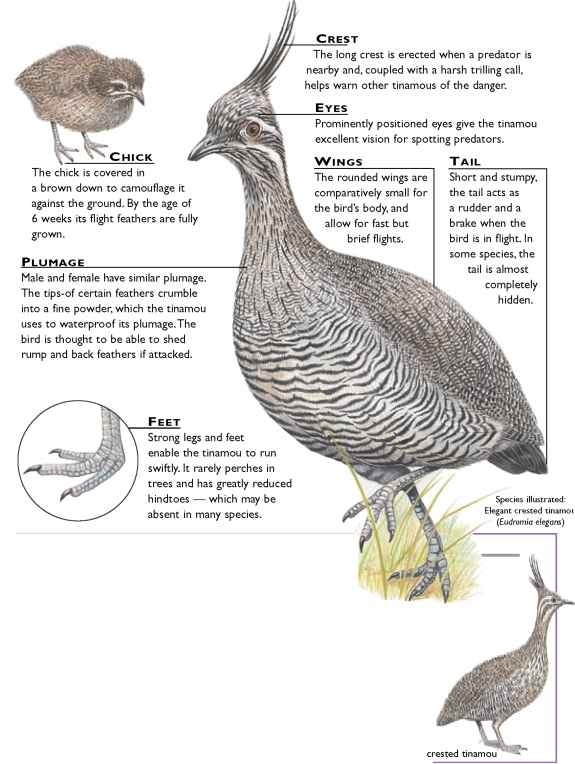
CREATURE COMPARISONS
Like the elegant crested tinamou, the Himalayan monal pheasant (Lophophorus impejanus) has a broad diet of plant and animal matter But the pheasant forages in steep, wooded valleys, whereas the tinamou keeps to lowland grasslands.The male pheasant (left) has a spur on the back of each leg, which he is thought to use against rivals. His bright plumage includes a crest, which he flaunts to attract a mate.The female has much more subdued plumage.The dull-brown coloring hides her— and the male tinamou — from predators, as each incubates Himalayan^i its egg clutches in deep undergrowth. Elegant
monal pheasant
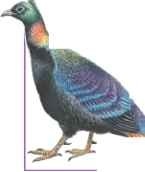
| VITAL STATISTICS Weight |
5.5 oz.-4.5 |
| lbs.; varies by | |
| species | |
| Length | 5-20″; varies |
| by species | |
| 10-28″ | |
| Wingspan | |
| 1 year | |
| Sexual | |
| Maturity | |
| Seasonal in | |
| Breeding | temperate |
| Season | areas |
| Number | Up to 16 |
| of Eggs | |
| Incubation | 17-24 days |
| Period | |
| Fledging | 25-42 days |
| Period | |
| Breeding | 1 or 2 |
| Interval | clutches a yr. |
| Typical | Plant matter, |
| Diet | invertebrates |
| Lifespan | Unknown |
Related species
• There are 45 species of tinamou divided into 2 subfamilies within the family Tinamidae. All are ground-dwelling and are found only within Central and South America. However, the subfamily Tinaminae contains forest dwellers, whereas the subfamily Rhynchotinae holds grassland species. Tinamous are in the order Tinamiformes — one of I the oldest bird orders.
